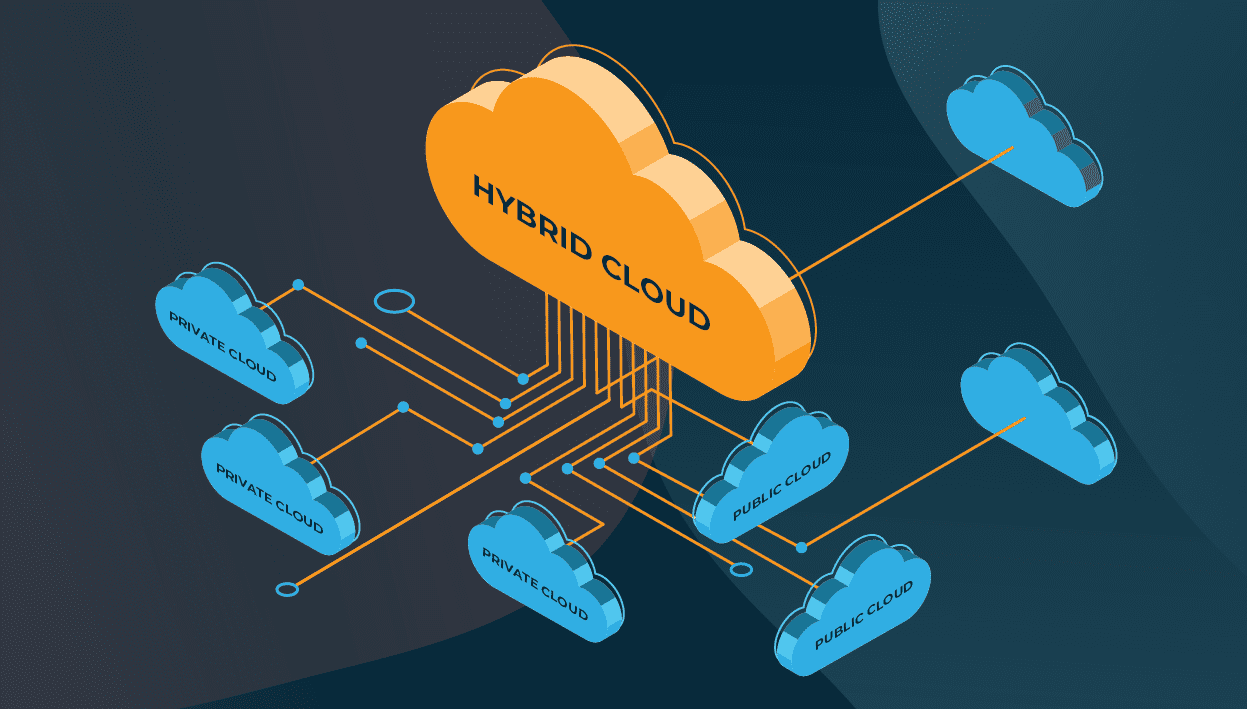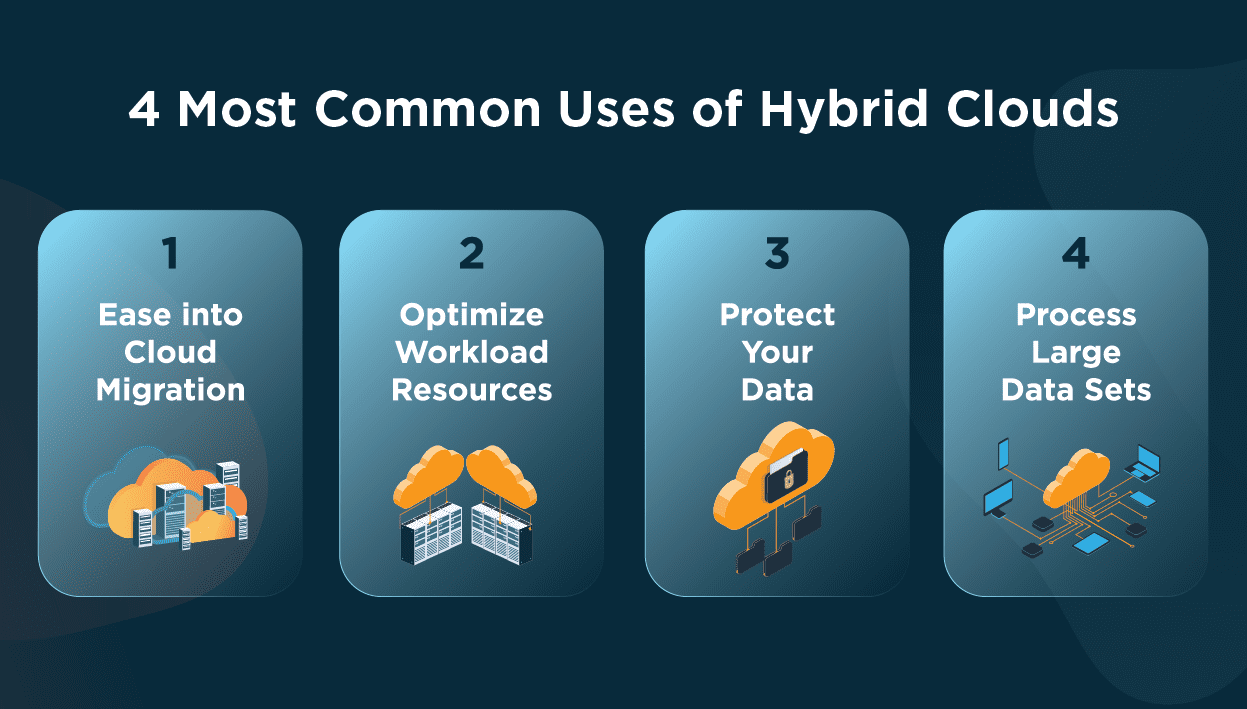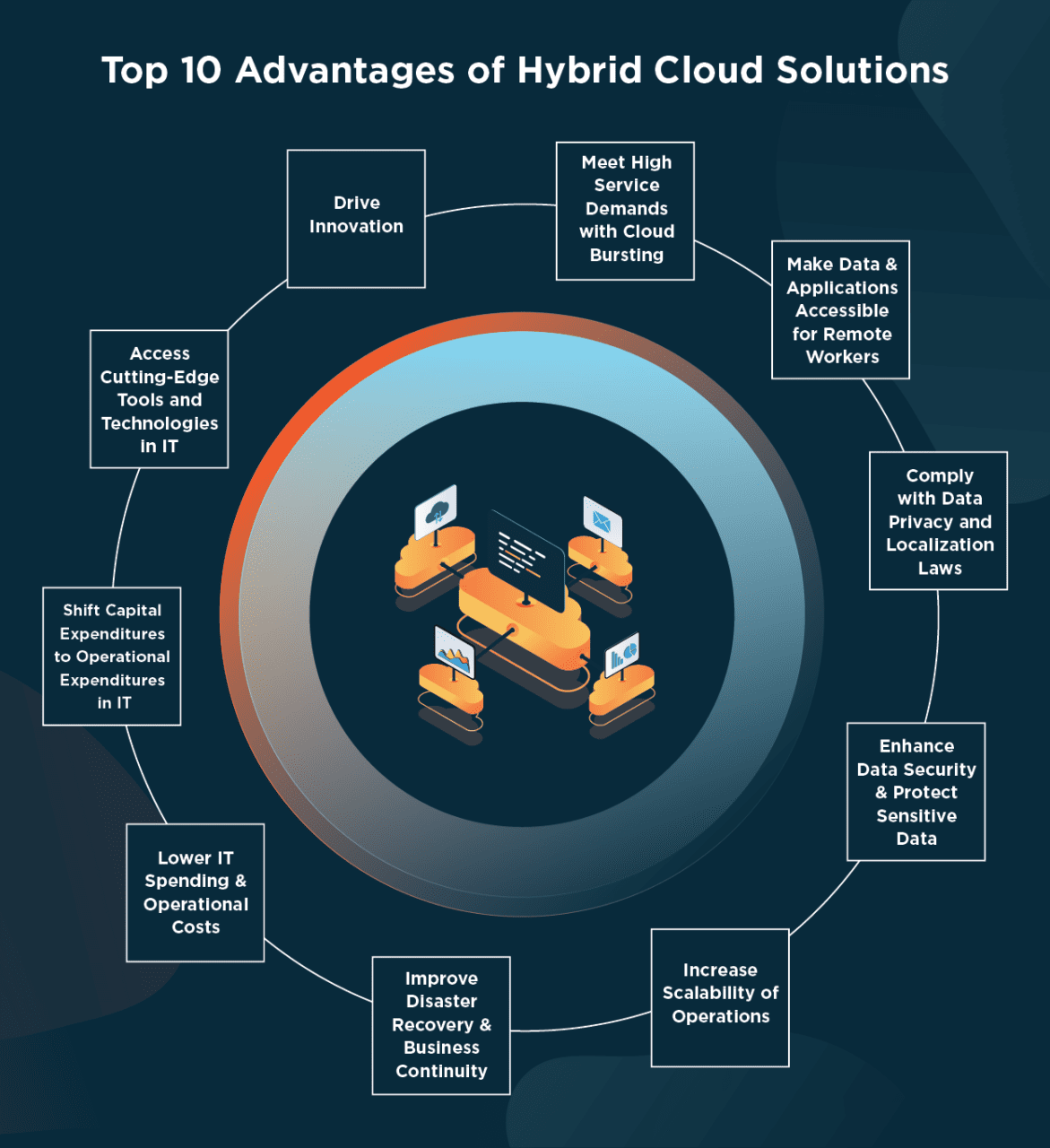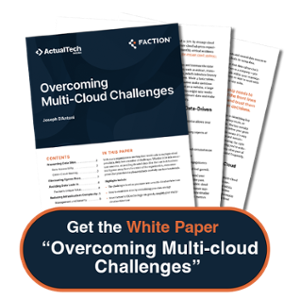Top 10 Advantages of a Hybrid Cloud Solution


The hybrid cloud market is growing rapidly as organizations strive to
- Reap the cost and efficiency benefits of public cloud services
- Protect the security of their data
- Avoid vendor lock-in
- Set the stage for a smooth future growth trajectory
We’ll explore the top ten strategic business advantages of hybrid cloud solutions and why your organization should get on board.
What is a Hybrid Cloud Solution?
A hybrid cloud solution is one that combines private cloud infrastructure with one or more public cloud services. Hybrid clouds may also include on-premise infrastructure and data centers, colocation infrastructure, and managed colocation or data hosting services.
A defining feature of hybrid cloud systems is that they allow for workload and data portability and application orchestration across multiple computing environments. Hybrid cloud solutions empower enterprise organizations to coordinate workloads between connected environments, orchestrate processes across multiple applications, and exercise greater control and governance over IT systems and resources.


Learn About Public vs. Private vs. Hybrid Clouds ➝
What are the Most Common Uses of a Hybrid Cloud Solution?
Over the past decade, hybrid cloud solutions have allowed organizations to create a competitive advantage for themselves by accessing higher performance capabilities and services on-demand than they would be able to build out in their data centers. Typical use cases for hybrid cloud include:
- Ease into Cloud Migration: Organizations are implementing hybrid cloud solutions to support the migration of on-premise data and application workloads into the cloud, with objectives that include lowering costs, increasing IT efficiency, and reducing time-to-market for new products and services.
- Optimize Workload Resources: Organizations can use hybrid cloud systems to leverage the optimal computing environment for every workload. Process complex workloads in the public cloud where additional capacity is low-cost and easy to access, but keep your simpler workloads on-prem or in private cloud infrastructure.
- Protect Your Data: Organizations store sensitive financial or customer information on private infrastructure and less sensitive data in the public cloud.
- Process Large Data Sets: Organizations can unlock the power of their big data by augmenting their on-prem infrastructure with public cloud capabilities. Businesses access the computing resources needed to analyze big data sets and extract insights that can drive business decision-making.
The IBM Institute for Business Value asked over 1,000 business leaders across 18 industries to identify the strategic objectives underlying hybrid cloud adoption within their organizations. In total, 54% of respondents said they were adopting the hybrid cloud to lower the total ownership cost of information technology, 42% said they hoped to increase operational efficiency within the IT organization, 42% hoped to facilitate and accelerate innovation, and 40% believed that adopting hybrid cloud solutions would help the organization meet customer expectations more readily in the future.


Watch How to Implement a Hybrid Cloud Solution ➝
What are the 10 advantages of hybrid cloud solutions?
- Meet High Service Demands with Cloud Bursting
- Make Data & Applications Accessible for Remote Workers
- Comply with Data Privacy and Localization Laws
- Enhance Data Security & Protect Sensitive Data
- Increase Scalability of Operations
- Improve Disaster Recovery & Business Continuity
- Lower IT Spending & Operational Costs
- Shift Capital Expenditures to Operational Expenditures in IT
- Access Cutting-Edge Tools and Technologies
- Drive Innovation
1. Meet High Service Demands with Cloud Bursting
Hybrid clouds help organizations satisfy periods of high demand for applications or services without the high costs of overprovisioning their own data centers for peak demand. Configure your applications that normally run on private cloud or on-prem to burst into the public cloud during times of excess demand, when additional computing resources are required to supply the necessary capacity and ensure customer satisfaction.
Cloud bursting is especially useful for industries and organizations that see regular fluctuations in their demand for data and application services. For example, financial applications experience surges in demand at the end of each quarter and during tax season. Another example is the retail industry, where seasonal events like Christmas and Black Friday result in greater volumes of web traffic and more purchases.
Cloud bursting is a great way for organizations in these and other industries to maintain high-quality customer experiences in periods of high application demand.
2. Make Data & Applications Accessible for Remote Workers
Cloud-hosted data and applications can be accessed from anywhere in the world by members of your organization with the appropriate authorization. In contrast, data and applications stored in on-premise data centers may be difficult to access or experience unacceptable lag times for other geographies.
Organizations with hybrid cloud solutions can leverage their infrastructure to provide employees with remote access to cloud-based and on-prem data and applications.
3. Comply with Data Privacy and Localization Laws
Organizations in some industries are subject to data security and privacy regulations such as
- Health Insurance Portability and Accountability Act (HIPAA)
- European General Data Privacy Regulation (GDPR)
- Payment Card Industry Data Security Standard (PCI DSS)
Many countries have also passed data localization laws that require organizations to store personal customer data in the same country where it is collected.
With hybrid cloud solutions, organizations do not need to build data centers in each country they operate in. They can store locally gathered customer data in public cloud regions that comply with data localization requirements and protect their customers’ privacy as required by law.
4. Enhance Data Security & Protect Sensitive Data
Hybrid cloud solutions give organizations greater flexibility when it comes to securing their data. Businesses can store their most sensitive data in on-premise data centers where it is difficult for malicious actors to attack. At the same time, use public cloud storage for easily and quickly processing and analyzing less-sensitive data.
5. Increase Scalability of Operations
Public cloud services providers have made data storage and computing resources affordable and accessible at scale for businesses. Organizations can scale their operations on an
- As-needed basis and avoid the capital expenditures
- Management requirements
- Technical overhead associated with building or expanding on-premises data centers
6. Improve Disaster Recovery & Business Continuity
Organizations that rely on hybrid cloud are now developing portable applications that can run on either on-premise or public cloud infrastructure. Portable applications offer a significant competitive advantage when the organization experiences a service outage and must execute its disaster recovery strategy to maintain business continuity and avoid unplanned downtime that negatively impacts the customer experience.
7. Lower IT Spending & Operational Costs
Reducing IT spending and lowering total cost of ownership are key strategic objectives that have driven hybrid cloud adoption over the past five years.
Organizations that depend on on-prem infrastructure and data centers need enough servers to meet customer expectations during peak usage times. An organization might invest in 500 servers to accommodate peak demand, but require just 200 servers during normal or “average” demand periods. Buying for peak demand results in underutilization of IT resources and inefficient IT spending.
In contrast, an organization with hybrid cloud capabilities could invest in just 200 servers and rely on public cloud vendors to supply additional resources during times of peak demand. As a result, these organizations benefit from
- Higher utilization rates for IT resources
- Lower costs
- More efficient IT spending
8. Shift Capital Expenditures to Operational Expenditures in IT
Adopting hybrid cloud solutions can create tax advantages for organizations in Canada, the United States, and other jurisdictions.
Purchasing servers for a data center is considered a capital expenditure in the tax code. As a result, the servers are codified as a business asset and must be depreciated on a yearly basis until the end of their life cycle. If an organization spends $5,000 on a server that is expected to last five years, they would have to depreciate the asset by $1,000 per year for five years to claim the full tax benefit.
Purchasing cloud services, however, is considered an operating expenditure – not a capital expenditure. Operating expenditures are not subject to depreciation – the organization can claim the full amount of the expense as an income reduction in the same year that the costs were incurred. This means that an organization purchasing $5,000 in public cloud services could claim the entire tax benefit right away and reduce their tax liability accordingly.
9. Access Cutting-Edge Tools and Technologies
Organizations with hybrid cloud capabilities enjoy the maximum flexibility when it comes to discovering and implementing best-of-breed technologies to support every application workload. The ability to deploy any application to the computing environment which promises the best performance, lowest costs, and most reliable service can create significant competitive advantages. Orgs can expand their access to technology and avoid cloud vendor lock-in by integrating more than one public cloud into their hybrid cloud solution.
10. Drive Innovation
Hybrid cloud solutions are driving innovation, making it easier for firms to build new services, and empowering organizations to better meet the needs of their customers. Businesses can use public cloud resources to develop and test new applications, then deploy them into production as needed.


Power Your Business with Faction Hybrid Cloud Solutions
Faction builds powerful cloud technology products that help organizations derive the maximum benefit from their investments in hybrid cloud solutions.
Faction Hybrid DRaaS (HDRaaS) is a flexible disaster recovery service that makes it easy and cost-effective to protect data and applications while managing your failover needs. Faction Cloud Control Volumes provides scalable back-end storage that’s directly connected to public clouds through our high-speed, proprietary network technology. Faction Multi-Cloud Data Services protect your data while reducing your storage footprint through deduplication efficiencies.
Together, these solutions allow organizations to replicate and protect on-prem workloads, reduce data storage costs, and make the most of their big data assets.
Are you ready to future-proof your IT infrastructure with Faction?
